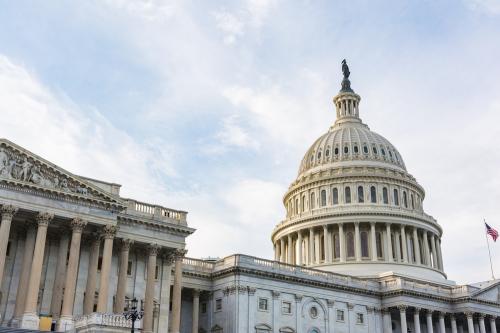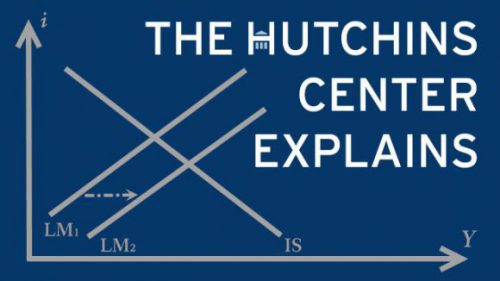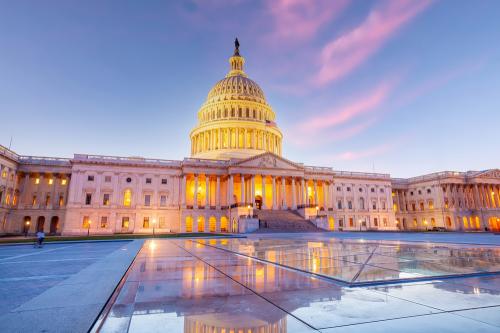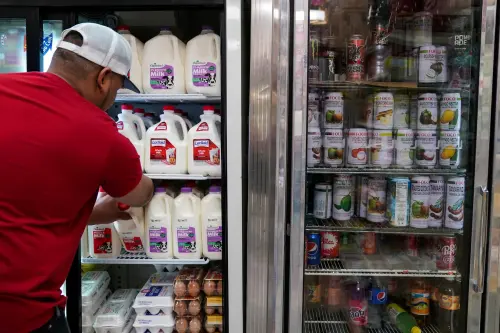This piece was originally published in July 2023. It has since been updated to reflect ongoing developments.
At the end of March 2024, Congress again averted government shutdown at the last minute—and finally funded the government for the full fiscal year (which was already six months old).
In November 2023, Congress passed an unusual continuing resolution (dubbed a “laddered CR”) that continued funding at last year’s levels agencies funded by four appropriations bills (Agriculture, Energy and Water, Military Construction-Veterans, and Transportation-HUD)—until January 19, 2024. On January 18, Congress avoided a partial government shutdown by extending that deadline until March 1. Funding for agencies covered by the other eight appropriations bills, including Defense, had been slated to expire on February 2, 2024; the January 18 legislation extended that deadline to March 8. At the end of February, Congress extended the deadlines again—to March 8 for six appropriation bills, which finally passed Congress late in the day on March 8, funding those agencies through the end of the fiscal year in September 2024, and March 22 for the remaining six, including Defense and Homeland Security. In the early morning hours of March 23, the Senate passed and sent to the president those six appropriations bills.
Why do government shutdowns happen?
Under the Antideficiency Act (initially passed in 1884 and amended in 1950), federal agencies cannot spend or obligate any money without an appropriation (or other approval) from Congress. When Congress fails to enact the 12 annual appropriation bills, federal agencies must cease all non-essential functions until Congress acts. This is known as a government shutdown. If Congress enacts some but not all of the 12 appropriations bills, only agencies without appropriations have to shut down; this is known as a partial shutdown.
What happens when that occurs?
During shutdowns, many federal employees are told not to report for work, though under a 2019 law they get paid retroactively when the shutdown ends. Government employees who provide what are deemed essential services, such as air traffic control and law enforcement, continue to work, but don’t get paid until Congress takes action to end the shutdown. All this applies only to the roughly 25% of federal spending subject to annual appropriation by Congress.
Benefits such as Social Security and Medicare continue to flow because they are authorized by Congress in laws that do not need annual approval (although the services offered by Social Security benefit offices may be limited during a shutdown). In addition, the Treasury can continue to pay interest on U.S. Treasury debt on time.
Shutdowns can be disruptive, leading to delays in processing applications for passports, small business loans, or government benefits; shuttered visitor centers and bathrooms at national parks; fewer food-safety inspections; and various inconveniences. Shutdowns are sufficiently likely that the White House Office of Management & Budget posts detailed contingency plans that government agencies maintain for shutdowns, as well as a 51-page Q&A on shutdown procedures.
The plans are often quite specific. The Securities and Exchange Commission’s contingency plan, for instance, cautions: “During the shutdown, employees who have not been designated as excepted may not volunteer to work without pay. Such voluntary services are a violation of the Antideficiency Act and will not be permitted under any circumstances.” The Advisory Council on Historic Preservation says, “A staff person will be instructed to ensure that, at the end of the last day of work with appropriated funds, lights and electronic devices not needed during the shutdown are turned off.” Some agencies say operations will continue if they haven’t spent previously appropriated sums or if they have income from fees that they can tap. The National Gallery of Art, for instance, says it will remain open as long as it can tap such reserves, but will have to close if the shutdown lingers. And the Centers for Disease Control says that 46% of its employees (or 6,448 individuals) will remain on the job, including 2,518 who are “exempt” because their activities or positions are funded outside of the usual annual appropriation process, and 3,930 who are “excepted” because their activities are deemed necessary by implication, or for the safety of human life or protection of property.
What about the courts and Congress?
In a 1981 opinion, Attorney General Benjamin Civiletti said that the president could continue to exercise his constitutional responsibilities during a shutdown. With that logic, lawyers for the federal courts and Congress have said that judges and members of Congress – and those who support them in their essential duties – can stay on the job even if the appropriations bills that fund them lapse. But some judicial and congressional employees are furloughed.
In a shutdown, according to the Administrative Office of the U.S. Courts, federal courts continue to operate for a while by drawing on fees they have collected (as distinguished from appropriations) and by delaying new hires, non-case related travel, etc. If the shutdown is prolonged and those funds are spent, then the courts say they can continue work that supports their constitutional powers.
As for Congress, the Congressional Research Service says, “Due to their constitutional responsibilities and a permanent appropriation for congressional pay, members of Congress are not subject to furlough.” Only those congressional staffers whose work is “required to support Congress with its constitutional responsibilities or those necessary to protect life and property” can remain on the job. But even those congressional staff don’t get paid during a shutdown, though they do get paid retroactively.
Why did a shutdown look likely in the fall of 2023?
In June 2023, with the backing of Republican leaders in the House and Senate, Congress passed and President Biden signed the Fiscal Responsibility Act, which lifted the ceiling on the federal debt and set limits on annual appropriated spending—one for defense, one for non-defense—for the fiscal years 2024 (which begins October 1, 2023) and 2025. At the time, the expectations were that this settled the overall size of the appropriations bills, and Congress would pass 12 bills that added up to the agreed-upon levels. The Senate Appropriations Committee has followed that path and has passed all 12 appropriations bills with bipartisan support. But House Republicans, unhappy with the agreement Speaker Kevin McCarthy struck with the White House, want to spend less than the levels specified in the Fiscal Responsibility Act—much to the consternation of Democrats and the White House, which says President Biden would veto the appropriations bills that are pending in the House. The House bills also include provisions on abortion, contraception, regulation of tobacco, and healthcare for trans persons that aren’t likely to pass the Senate.
When the House and Senate pass different bills, the next step is a conference committee at which the two chambers are supposed to forge a compromise, which goes to a vote in each chamber before going to the president. That is likely to be very contentious.
What is a continuing resolution?
When Congress hasn’t passed appropriations bills for an entire fiscal year, it sometimes passes temporary spending bills—continuing resolutions—that fund government operations until a specified date. Continuing resolutions often, although not always, continue the level of funding at the prior year’s appropriations level. According to the Government Accountability Office, there were 47 continuing resolutions (often known as “CRs” inside the Beltway) between fiscal years 2010 and 2022. They ranged from one day to just under six months. Although they keep the government operating, the GAO said they can be difficult for government agencies to manage, because they often have to plan for a government shutdown because they can’t be sure a CR will pass, they can disrupt agency hiring plans, and they make planning difficult.
The Fiscal Responsibility Act has an unusual feature that was intended to discourage Congress from funding the government with a continuing resolution beyond the end of December 2023. It didn’t have the intended effect. The law said that if a CR were in effect on January 1, 2024 (and that was the case), then limits on spending would be automatically revised downward from the levels set in the law. But the White House Office of Management and Budget said in a December 2023 memo that the law delays any action to restrain spending to comply with those lower limits until April 30. If Congress enacts full-year appropriations before April 30, it would likely waive those lower spending limits before they take effect.
How common are government shutdowns?
There have been four shutdowns where operations were affected for more than one business day. In 1995-1996, President Clinton and the Republican Congress were unable to agree on spending levels; the government shut down twice, for a total of 26 days. In 2013, a standoff over funding for the Affordable Care Act resulted in a 16-day shutdown. And in December 2018 and January 2019, a dispute over border wall funding led to a shutdown that lasted 35 days; it was a partial shutdown because Congress had previously passed five of the 12 appropriation bills.
What impact do government shutdowns have on the overall economy?
A shutdown of a few days is a hassle—and undermines public confidence in the capacity of U.S. politicians to do the people’s business—but is unlikely to have a significant impact on the economy. A prolonged shutdown, however, can cause bigger problems, albeit most temporary. Goldman Sachs estimates that a shutdown would reduce GDP growth by about 0.2 percentage point each week it lasts, and that growth would rise by the same amount in the quarter following the shutdown’s end.
The Congressional Budget Office estimated that the five-week partial shutdown in late 2018 and early 2019—partial because five of the 12 appropriation bills had been passed—reduced the level of GDP growth by 0.1% in the fourth quarter of 2018 ($3 billion in 2019 dollars) and by 0.2% in the first quarter of 2019 ($8 billion), mainly from the loss of furloughed federal workers’ pay and the delay in federal spending on goods and services. “Although most of the real GDP lost…will eventually be recovered, CBO estimates that about $3 billion will not be,” CBO said. In other words, the GDP in 2019 was estimated to be 0.02% lower because of the shutdown than it otherwise would have been. The CBO estimates did not account for such indirect effects as the inability of some businesses to obtain federal permits or apply for federal loans.
-
Acknowledgements and disclosures
The Brookings Institution is financed through the support of a diverse array of foundations, corporations, governments, individuals, as well as an endowment. A list of donors can be found in our annual reports published online here. The findings, interpretations, and conclusions in this report are solely those of its author(s) and are not influenced by any donation.






Commentary
What is a government shutdown?
March 23, 2024